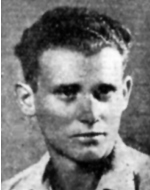Spiegel, Israel-Chaim (Isidore, Izzy)
Chaim, son of Gitel and Moshe-Yosef, was born in Romania in the city of Karola (Curly-Marie) on the Hungarian border in 1925. His father, who was involved in commerce and industry, was one of the founders of the local Jewish community. And in 1940, shortly after the start of World War II, he was returned to Hungary, and as a German protectorate, Hungary had already passed a series of laws in 1938 Anti-Jewish, similar to the “Nuremberg Laws.” From the summer of 1939, Jewish men were taken to the Hungarian army’s Munkaszolgalat (Labor Service) After the German occupation of Hungary in March 1944, the Jews of the country were concentrated in ghettos and sent to extermination camps, and most of the Jews of Karola were murdered in Auschwitz, and by the end of the war half a million Hungarian Jews died. Chaim was sent to the forced labor camps with other youth, but was forced to work in forced labor, but he survived the liberation day in 1947. He settled in Jerusalem and shortly thereafter began working at the Hebrew University. When the War of Independence broke out Haim was recruited and assigned to the “Etzioni” Brigade – the 6th Brigade of the Hagana, whose fighters came from Jerusalem and the surrounding area. Served in Company C in the 67th Battalion. He participated for many months in defending the city, its roads, and the surrounding settlements. One of the main focal points of the conflagration in Jerusalem was the “Mandelbaum House” (now Central Command Square). These were houses on the border between the Jewish neighborhoods in the north of the city and the Arab neighborhoods in the area. Near the Mandelbaum houses, there was an important junction of roads leading to Mount Scopus. Due to the importance of the junction, many battles took place in the area at the beginning of the war, which expanded after the declaration of independence, when one of the Jordanian army’s invasion routes passed to Jerusalem. The Hagana forces managed to hold several adjacent houses in the neighborhood and turned them into Israeli positions. When the “Ten Days” battles broke out in July 1948, at the end of the first truce in the war, the Jordanian army tried to take control of the area in order to obtain an outpost in the north of the city and threaten the Jewish neighborhoods. On July 12, 1948, the Jordanians began a heavy bombardment of the houses of Mandelbaum and four days later attacked and conquered several of the Israeli positions. The fighters of Etzioni responded with counter-attacks and reoccupied the positions. For four consecutive days, some of the difficult battles that Jerusalem experienced during the War of Independence took place in the region, with the positions and houses taking over both sides. The battles reached their climax on the 11th of Tammuz 5708 (18.7.1948), the day before the second truce in the war. Fifteen Israeli fighters fell in the battles that took place on this day, and lived among them. At the end of the fighting and the beginning of the truce, the Jordanians stopped and withdrew to their previous positions. Since then, the Mandelbaum houses have moved to the new frontier between Israel and Jordan, which later became known as the “Jerusalem municipal border.” After the war, this area was the only official crossing between Israel and Jordan until the Six-Day War. Chaim was twenty-three years old when he fell. He was buried in Sheikh Bader Aleph. On the 28th of Elul 5710 (10.9.1950) he was transferred to eternal rest in the military cemetery on Mount Herzl in Jerusalem. This hero is a “last scion”. The last survivor of the Holocaust is Holocaust survivors who have survived the last remnant of their nuclear family (parents, brothers, sisters, sons and daughters), who experienced the Holocaust in the ghettos and / or concentration and extermination camps and / or in flight and mass.In the territories conquered by the Nazis and / or fighting alongside members of the underground movements or partisans in the Nazi-occupied territories who immigrated to Israel during or after World War II, wore uniforms and fell in the Israeli army.
